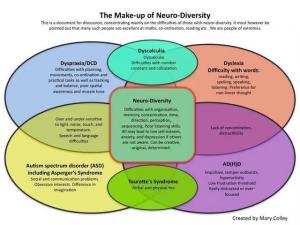Neurodiversity covers a range of developmental conditions including ADHD Autism (or ASD), Dyslexia, Dyspraxia, Dyscalculia

NeuroDiversity Map
These are classed as developmental disorders or conditions. This means that the brains of those with these conditions develop differently, and more slowly than others. This gives rise to different ways of seeing the world, different skills, and difficulties to a greater or lesser extent. They are also classed as disabilities. There are a range of possible traits of each of these conditions, and not everyone who has any of these conditions will have all the traits. It’s also common for people to have more than one of these conditions. The list of traits for each condition overlap.
So far, only Autism is named as a spectrum disorder. The spectrum does not refer to the severity of the difficulties experienced but to a range of traits. Each person will display a unique combination of traits. Severity tends to be expressed in the level of support needed to function in the neurotypical world. Often, if those with these conditions manage to cope fairly well in the world, and/or mask their true feelings, they are not identified as having the condition. This causes them to struggle without understanding why and without help. This frequently attracts criticism, which can typically lead to poor self-image. It is now thought that these conditions are actually far more common than has been thought, and underpin numerous struggles, which become problems in other ways, such as anxiety, depression, substance misuse and criminality.
Getting help
Understanding if you have neurodiverse traits and getting help to overcome the difficulties with a toolkit of techniques can relieve a great deal of distress. It’s not a cure, but it can lead to a happier life, and increased success at what you value. Being happier with yourself and your life also reduces guilt, shame and poor self-worth leading to higher self-esteem. I have much knowledge, expertise, and experience in helping people pinpoint their difficulties and access and use an appropriate toolkit to improve their functioning and emotional distress. I am not qualified to diagnose these conditions for NHS funding purposes, but can certainly help you identify if it’s likely you have one or more so you can discuss with your GP for diagnosis.
Contact me to discuss how I can help.
Below are some of the traits of each condition to give you an idea if you are new to the subject.
ADHD
Attention Deficit and Hyperactivity Disorder. Many people with this disability, and who work with those with it, feel that this is totally the wrong name. One of the main issues is that there may be no deficit of attention, but attention may be impossible for some things, and in over whelming supply, creating a state of hyperfocus which makes paying attention to anything else impossible. Hyperactivity may be obvious, such as not sitting still but always on the move, or more internal such as fidgeting, playing with hair or wholly internal such as a constant stream of thoughts and ideas. Impulsivity is the third main trait which may lead to risky behaviour, thrill seeking, and addictive emotional coping habits. There are many traits of ADHD which are not described in the main diagnostic criteria, such as being disorganised, being often late, emotional mood swings, sensitive to criticism, poor working memory leading to the out of sight out of mind phenomena, procrastinating.
Autism Spectrum Disorder (ASD)
ASD Is recognised by a range of traits, the most known of which is communication difficulties. Some don’t talk at all. Some can converse articulately, but may not make eye contact and may not read the other person’s response and feelings accurately. Research has show that people with Autism tend to communicate with each other much better than with neurotypical people. Thus, it could be understood that the difficulty is in translation between the autistic experience of the world and the neurotypical. Autistic people thus may not form friendships easily if surrounded by neurotypical people. Another common trait is that of sensory sensitivities. Typically, the senses are much more sensitive and so the world can be overwhelming and disturbing. Lights may seem far too bright, sounds too loud, smells nauseating, and textures unbearable. Many Autistic people also use a strong sensory experience to calm themselves because it is often the unexpected uncontrollable and mixed sensory experience that overwhelms. Many autistic people struggle with change and may stick to rigid routines and repetitive behaviours to keep a feeling of control. This can also extend to intense hobbies or pastimes, often involving collecting and organising a collection. Autism can also involve executive function difficulties, such as difficulty starting a task or switching tasks. Some people with autism also ave sensory processing disorders and, in particular, understanding speech in noisy environments and specifically mishearing consonants.
Dyslexia
The most common trait is difficulty with reading writing and spelling. People with dyslexia have trouble with sequencing, so for instance, all the letters may be there when they spell a word but in the wrong order. Letters are frequently reversed when writing. This makes reading difficult for some because the words don’t look as if they are in the right order. Some people with dyslexia report that words jump around as they look at them. The difficulty with sequencing can also make following a list of multiple instructions difficult. People with dyslexia are often ambidextrous or left-handed. They may also confuse right and left. Other traits include disorganisation poor concentration and a greater ability to demonstrate knowledge and understanding verbally than in writing.
Dyspraxia
The core traits of dyspraxia are difficulties with fine and gross motor skills, coordination and balance, speech, auditory and verbal processing, organisational skills, planning, sequencing, learning new processes, time management.
Dyscalculia
Traits include difficulties with counting numbers, memorising sequences of numbers, determining which is bigger or smaller, understanding time, identifying number patterns, sense of direction & left & right, handling money and working out change.

